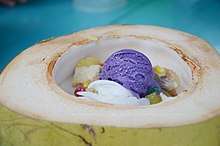Halo-halo
Halo-halo (Tagalog for "mix-mix"), also spelled haluhalo, is a popular Filipino cold dessert which is a concoction of crushed ice, evaporated milk and various ingredients including, among others, ube, sweetened beans, coconut strips, sago, gulaman (seaweed gelatin), pinipig rice, boiled root crops in cubes, fruit slices, flan, and topped with a scoop of ice cream.
 A bowl of halo-halo | |
| Course | Dessert |
|---|---|
| Place of origin | Philippines |
| Main ingredients | Shaved ice, milk, various fruits |
History

Halo-halo is believed to be an indigenized version of the Japanese kakigori class of desserts, originating from pre-war Japanese migrants into the islands. The earliest versions were composed only of cooked red beans or mung beans in crushed ice with sugar and milk, a dessert known locally as "mongo-ya". Over the years, more native ingredients were added, resulting in the development of the modern halo-halo.[1][2]
Some authors specifically attribute it to the 1920s or 1930s Japanese migrants in the Quinta Market of Quiapo, Manila, due to its proximity to the now defunct Insular Ice Plant, which was the source of the city's ice supply.[3]
The spelling "halo-halo" (popularized by Chowking) is considered incorrect by the Commission on the Filipino Language, which prescribes "haluhalo". The word is an adjective meaning "mixed" in Tagalog, a reduplication of the verb halo ("to mix").
Description

Ingredients can vary widely, but they usually include sugar palm fruit (kaong), coconut sport (macapuno), saba plantains cooked in syrup (minatamis na saging), jackfruit (langkâ), agar jellies (gulaman), tapioca pearls, nata de coco, sweet potato (kamote), sweetened beans, cheese, and pounded toasted young rice (pinipig), among others. Most of the ingredients (fruits, beans, and other sweets) are first placed at the bottom, followed by the shaved ice. This is then topped with either (or a combination of) leche flan, ube halaya (mashed purple yam), or ube ice cream (sometimes vanilla). Evaporated milk is poured into the mixture upon serving.
A similar Visayan dessert binignit is also referred to as "ginataang halo-halo" in Tagalog ("halo-halo in coconut milk"), commonly shortened to "ginataan". It is made with mostly the same ingredients, although the latter is usually served hot.[4][5]
In popular culture
Halo-halo was featured as a Quickfire Challenge dish in the seventh episode of the fourth season of the American reality television series Top Chef. The halo-halo, which featured avocado, mango, kiwi, and nuts, was prepared by Filipino-American contestant Dale Talde and named as one of the top three Quickfire Challenge dishes by guest judge Johnny Iuzzini of Jean Georges. Talde also made the dish in a later episode.[6]
Halo-halo was featured in an episode of Anthony Bourdain: Parts Unknown when its host Anthony Bourdain visited a Jollibee branch in Los Angeles. Bourdain praised the dessert and even posted a photo of Jollibee's halo-halo on his Twitter account, which he described as "oddly beautiful."[7][8]
The dessert was featured on a Delicious Destinations edition episode of Bizarre Foods.[9]
References
- Ocampo, Ambeth R. "Japanese origins of the Philippine 'halo-halo'". Philippine Daily Inquirer. Retrieved 23 April 2019.
- "Halo-Halo Graham Float Recipe". Pinoy Recipe at Iba Pa. Retrieved 24 July 2019.
- Crisol, Christine (2006). "A Halo-Halo Menu". In Zialcita, Fernando N. (ed.). Quiapo: Heart of Manila. Manila: Quiapo Printing. p. 321. ISBN 978-971-93673-0-7.
Today, many non-Quiapense informants in their forties and older associate the Quinta Market with this dessert. Why did this market become important in the invention of this dessert? Aside from its being a Japanese legacy in the area [...] of all the city markets, the Quinta was closest to the ice.
- Merano, Vanjo. "Ginataang Halo-halo Recipe (Binignit)". Panlasang Pinoy.
- "Ginataan Halo-Halo". Filipino Food Recipes. Retrieved 13 May 2016.
- "The Restaurant". Taldebrooklyn.com. Archived from the original on 2014-07-18. Retrieved 2014-06-09.
- Flores, Helen. "Jollibee in LA gets thumbs up". The Philippine Star. Retrieved 24 April 2013.
- "Anthony Bourdain tries Jollibee halo-halo". ABS-CBN News. 22 April 2013. Retrieved 24 April 2013.
- Bizarre Foods with Andrew Zimmern#Season 18 - Delicious Destinations (Season 3.29
Further reading
- Connelly, Michael Alan (December 18, 2014). "20 Must-Try Street Foods Around the World". Fodor's. Retrieved July 24, 2016.CS1 maint: ref=harv (link)
External links
| Look up Halo-halo in Wiktionary, the free dictionary. |
